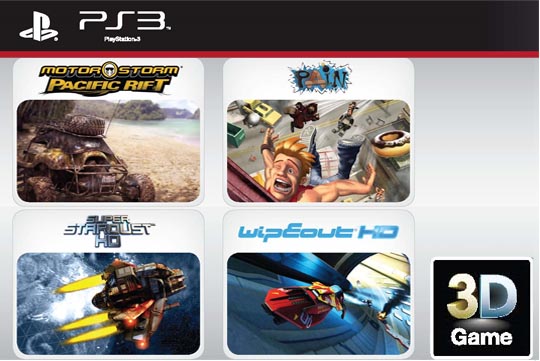PS3 3D gaming experience
 Sony has officially launched it’s new line of Bravia HDTVs with 3D, either built in, or 3D ready by adding a transmitter. To go along with the TVs, they’re also leveraging 3D games for the PS3. Here in Canada the TVs will come with PSN codes to download MotorStorm Pacific Rift and PAIN, both of which are demos, or partial games, and WipEout HD and Super Stardust HD, both full games.
Sony has officially launched it’s new line of Bravia HDTVs with 3D, either built in, or 3D ready by adding a transmitter. To go along with the TVs, they’re also leveraging 3D games for the PS3. Here in Canada the TVs will come with PSN codes to download MotorStorm Pacific Rift and PAIN, both of which are demos, or partial games, and WipEout HD and Super Stardust HD, both full games.
Yesterday at a launch event, we had a chance to go hands on with both MotorStorm Pacific Rift and Super Stardust HD, with mixed results. Before getting into the details, I have to state that I’m not a huge fan of 3D technology. I don’t hate it, but I don’t really care for it all that much, either. When watching 3D films, if I’m sitting the ‘recommeneded’ distance away, the 3D effect makes everything feel like it’s appearing in a terrarium, or marionette stage. When watching something in two dimensions, we tend to ‘forget’ the edge of the screen, especially when we’re engaged in what we’re watching. With 3D, we’re actively forced to notice the edges any time something on screen beyond them. That ‘real world’ edge immediately triggers our brains to recalculate scale, not based on the images themselves, but the combination of images and the real world. At least that’s how I see 3D, and when I rarely go to see a 3D feature, I sit closer to the screen to avoid feeling of watching something shot entirely with tilt-shift photography.
With that preamble out of the way, how did they look? find out
Both games were hooked up to the same 46 inch BRAVIA 1080p 3D LED HDTV (or the XBR46LX900), with very different results. In the bad news department, though the 3D effect was there, MotorStorm in particular suffered from the same problem that can be seen, with a noticeable dulling of the colours. The other problem was the fact that it appeared to be playing at 720p, and probably right around 30FPS. In 2D this would be fine, but for some reason, the aliasing of diagonal edges seemed to stand out even more. As soon as I stepped a couple of feet back to the ‘recommended’ distance for general HDTV setups, aliasing became less of an issue, but the terrarium effect was back. I felt like I was playing with an RC car, and an extra step removed from the game itself. It wasn’t a bad experience, but it was merely okay. Nothing to write home about, let alone shell out a cool four grand to experience on a regular basis.
On the other hand, Super Stardust HD was absolutely phenomenal in 3D. This may be in part due to the game running at a much higher frame rate, and playing in 1080p. Part of it may be that Super Stardust is in no way a ‘real world’, so the sense of scale is relative to the game, as opposed to MotoStorm, where the game world is in a recognizable human scale. In any case, the vibrancy of the colours was still there, and the 3D effect worked wonders. For the same reasons of arbitrary scale, the terrarium effect wasn’t a problem with this game either. Of course, it looks better when you’re sitting closer to the TV than you really should, as when you play from ‘proper’ viewing distance, it’s far less impressive.
We’ll have more on our experiences with other aspects of the 3D TVs, both good and bad (and surprisingly there was more good than I expected), in the next couple of days, including an interview with Karol Warminiec of Sony.




[…] other factor is resolution. As I noticed in Sony’s PS3 3D games, if you have to make resolution sacrifices to the game, the 3D looks pretty horrible. Motostorm […]
627644 833921I really like the look of your internet site. I recently built mine and I was looking for some design ideas and you gave me a couple of. Could I ask you whether you developed the web site by youself? 101292